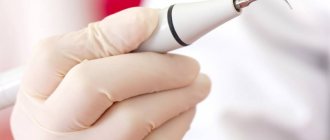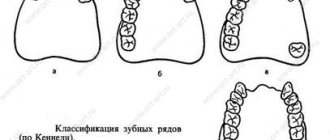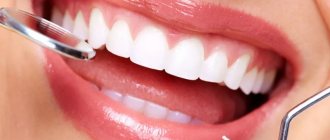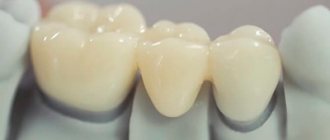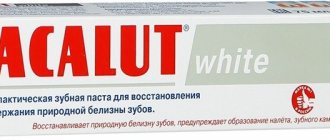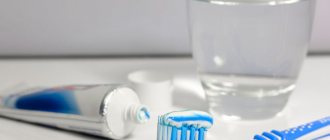Dental deposits are plaque and tartar that form on the surfaces of teeth and accumulate in the supragingival and subgingival space. Dental plaque not only makes our teeth unsightly - dull and yellow, but they contribute to the development of a wide variety of dental diseases of the teeth and gums. It is for this reason that it is imperative to remove dental plaque and do it in the dentist’s office, using professional techniques and equipment.
How dental plaque is removed in dentistry, by what methods and what is the price for the service in Moscow - we will answer all these questions in detail in this article.
What is dental plaque and how is it removed in dentistry?
Dental plaque is plaque that remains on the teeth after eating or drinking. This plaque contains large quantities of various bacteria and pathogenic microorganisms that harm the health of our teeth and gums. If soft dental deposits are not removed by regular brushing, they will gradually harden and turn into stone, which cannot be removed at home. Both hard and soft deposits on teeth increase the risks of developing caries, periodontitis and periodontal disease. Therefore, you need to deal with their timely removal.
Some people think that brushing their teeth every day will be enough to completely remove plaque, but this is not true. Even if you carry out dental hygiene according to all the rules and using all the recommended tools (brushes, brushes, floss), you will still not be able to carry out high-quality removal of deposits from hard-to-reach places in the oral cavity - interdental spaces, in the space above and below the gums. For this reason, to remove dental plaque, you need to go to dentistry and carry out the procedure using professional techniques and instruments.
To remove dental plaque in modern dentistry, various methods are used, and below we will consider in detail the most popular methods of cleaning teeth and the oral cavity from plaque and tartar.
Calculate the cost of treatment by taking a short test in 20 seconds!
Do not delay your treatment, because in this matter time plays against us.
Removing dental plaque: methods used in modern dentistry
To remove dental plaque in dentistry, physical and hardware methods can be used. In the first option, special tools are used to remove deposits - stone and plaque - hooks, scalers, finishers. However, the physical method of removing dental plaque is used quite rarely, only when there is a need to remove tartar from deep gum pockets, from which it is difficult to remove it in other ways.
Why has removing dental plaque with hand instruments become unpopular among modern dentists? It's simple, this method is less advanced than modern technologies for removing plaque and tartar. Manual removal of dental plaque is a labor-intensive process, the effectiveness of which will largely depend on the level of knowledge and qualifications of the dentist. Moreover, when manually removing dental deposits, irregularities remain on the teeth, in which plaque will accumulate even more actively.
Due to the considered disadvantages, manual removal of dental plaque is rarely carried out; hardware methods for removing plaque and tartar are more often used - Air Flow technology and ultrasonic cleaning.
Air Flow technology for removing dental plaque
This technology is ideal for removing soft and pigmented deposits from tooth surfaces.
The procedure for removing plaque is quick and without discomfort for the patient and, in addition to removing plaque, it helps to lighten the tooth enamel a little - by approximately 2-3 shades, to its natural shade. When removing dental plaque using Air Flow technology, teeth are cleaned by applying a powerful air-water flow to their surface, which contains abrasive particles (soda).
Air Flow dental plaque removal is an effective and gentle method of combating plaque, but with all its advantages, it does not help get rid of tartar. To carry out high-quality removal of hard dental deposits, teeth are cleaned with ultrasound. We will talk about this technology in detail in a separate section of our article.
How does Air‑Flow teeth cleaning work?
The Air‑Flow teeth cleaning device delivers a special mixture under high pressure in a directional manner. It consists of fine abrasive powder, water and air.
The jet delicately and thoroughly removes plaque from the enamel without damaging it. As a result, the teeth become smooth and brighten by 1–2 shades. But the Air-Flow method is not teeth whitening: the brightening effect is achieved by removing the soft bacterial film that causes teeth to become dull. With the disappearance of this film, their natural color returns.
Result of Air‑Flow teeth cleaning
- The enamel becomes smooth, and plaque practically does not settle on it
- Teeth brighten, acquire a natural shade and shine
- Bad breath disappears, breath becomes fresh and healthy
Ultrasound removal of dental plaque: features, stages and prices
Ultrasound removal of dental plaque is a modern and highly effective method of oral hygiene. Ultrasound will help:
- Carry out the removal of supragingival and subgingival tartar;
- Quickly remove pigmented plaque;
- Eliminate soft microbial plaque.
Removing dental plaque is a procedure that is carried out in three stages. Below we will tell you in detail how the process of removing dental plaque with ultrasound will take place in the dentist’s office.
STEP 1: Ultrasound removal of plaque and tartar
Ultrasound removal of dental plaque is carried out using special equipment - ultrasonic scalers.
Scalers can be either a separate device or part of a dental unit. The main working element of the scaler is its tip with a metal attachment. The tip of this metal nozzle vibrates at high frequencies in the ultrasonic range. Also, water is supplied through the nozzle, which washes away decayed dental plaque from the patient’s mouth and is immediately removed with a saliva ejector.
Main characteristics
The handyblaster is a pistol-shaped design consisting of 4 main parts.
- A container with abrasive, a lid and seals is the central part of the device.
- A tip attached to the front of the abrasive container.
- The nozzle is the direct working body. Attaches to the handpiece with a convenient, easy-to-actuate connection.
The tip of the nozzle has a 60° or 80° bend relative to the tip. A nozzle with a 60° bend is used to treat the molar and occlusal zones, with an 80° bend – for the anterior teeth. - The fitting at the back of the powder container is for connecting the device to the compressed air line.
The concept of using the Cavitron Select SPS ultrasound device and some recommendations.
Come here if you are interested in the capabilities of the Rondoflex device.
At this address https://www.vash-dentist.ru/lechenie/zubyi/opredelenie-stepeni-podvizhnosti.html we will consider ways to determine the degree of tooth mobility.
Design features
The device has an ergonomic design and optimal weight distribution. Prophy Mate fits comfortably in your hand without straining your hand.
The presence of 2 swivel joints with easy 360° rotation allows you to easily turn the tip of the nozzle in any direction with a slight movement of your fingers, and dampens the resistance of the air supply hose.
Nozzles with angles of 60° and 80° provide jet access to all areas of the dentition.
Air is supplied to the container through 2 nozzles. This creates a high-quality abrasive-air mixture that provides consistent power and improved polishing properties.
The design of the connection between the device and the air line is adapted to adapters from most well-known manufacturers of air-abrasive systems.
Free consultation on the cost of treatment in our dentistry
Leave a request and the clinic administrator will contact you within 15 minutes!
The scaler effectively removes dental plaque because:
1. Its nozzle creates oscillatory movements that destroy plaque and tartar. In order for the removal of dental plaque to be carried out efficiently and without damaging the teeth, it is extremely important that the vibrations of the nozzle are directed along the dental surfaces.
2. During the operation of the scaler, water is supplied to the oral cavity, which is needed not only to wash out destroyed deposits and cool the nozzle. Ultrasound in an aqueous environment creates many small bubbles, which immediately burst, releasing a large amount of energy. This energy promotes improved removal of dental plaque from tooth enamel, and in addition, helps eliminate pathogenic microflora in the oral cavity.
After removing plaque, the second stage of ultrasonic cleaning is carried out - teeth polishing.
STEP 2: Polishing teeth after removing dental plaque with ultrasound
Polishing teeth after removing dental plaque is an event that must be carried out without fail.
After removing deposits with ultrasound, microscopic particles of plaque and stone may remain on the dental surfaces, making the tooth enamel uneven and rough, which will provide optimal conditions for the accelerated accumulation of a new layer of plaque. Polishing teeth after removing deposits can be done with hand tools, but most often the Air Flow technology is used for polishing, which we briefly told you about above. When manually polishing teeth, after removing plaque, pastes, brushes and strips are used - thin strips with an abrasive layer, which polish the space between the teeth.
STAGE 3: Remineralization of teeth after removal of plaque and tartar
This stage is not considered mandatory and, moreover, many clinics do not include it in the procedure for professional removal of dental plaque.
However, remineralization must be carried out after removing plaque and tartar from the teeth. It helps strengthen tooth enamel and relieve sensitivity that may occur in the neck area of teeth after plaque removal. Remineralization of teeth is carried out immediately after removing plaque and tartar and uses special preparations based on sodium fluoride.
Equipment and service
The basic equipment of the Prophy Mate device includes:
- tip with nozzle 60° – 1 pc.;
- nozzle 80° – 1 pc.;
- abrasive container – 1 pc.;
- small mandrin (for cleaning the tip of the nozzle) – 1 pc.;
- large mandrin (for cleaning the lower part of the nozzles) – 1 pc.;
- universal mandrin – 1 pc.;
- brush for cleaning connections – 1 pc.;
- Flash Pearl powder – 5 packs;
- wrench for nozzle – 1 pc.;
- nozzle for blowing (removes powder residues from the device) – 1 pc.;
- oil;
- spare parts: o-rings, powder container cap.
Although the operation and maintenance of the device is very simple, several important rules must be followed when caring for it:
- After each procedure, you need to remove the abrasive from the container and internal channels by blowing air using a blowing attachment.
- Clean the nozzle channels with a mandrel.
- Wipe the tip of the nozzle with a cloth moistened with alcohol.
- Clean the joints with a special brush.
- Treat the tip in a thermal disinfector. The abrasive container cannot be processed in a thermal disinfector.
The entire disassembled device can be sterilized in an autoclave for 15 minutes at a temperature of 121°C. To prevent clogging of the device with abrasive, it is recommended to clean the Prophy Mate once a week in an ultrasonic bath.
Advantages of ultrasonic dental plaque removal
Ultrasound removal of plaque and tartar has a number of advantages. First of all, it is worth noting the high efficiency and versatility of the technology: it is ideal for removing pigmented plaque and perfectly removes stone from the most inaccessible areas of the oral cavity, even from deep periodontal pockets.
Removing plaque and tartar with ultrasound helps destroy pathogenic microflora in the oral cavity and, what is especially important, cleans periodontal pockets from pathogenic bacteria.
A clear advantage of removing dental plaque with ultrasound is the affordable cost of the procedure. On average, you will have to pay 4-5 thousand rubles for removing plaque and tartar, polishing and remineralizing teeth.
Indications for use
The device is intended for use exclusively by hygienists and dentists, and can be used for preventive and therapeutic purposes to solve the following problems:
- Professional teeth cleaning.
- Removal of biofilm and tartar from a clinical crown.
- Teeth whitening. Some sources talk about the possibility of teeth whitening. This is not entirely true.
To be completely precise in terminology, bleaching involves a chemical reaction in the bleaching gel with the release of atomic oxygen.When using Prophy Mate, there is no chemical reaction; coloring matter is removed from the teeth mechanically.
- Preparing teeth for etching enamel before filling, installing veneers, fixing braces, etc.
The list of contraindications includes the following pathologies in patients:
- respiratory diseases;
- deep (6 mm or more) gum pockets;
- pronounced pathologies of the mucous membrane of the PR and salivary glands - to avoid emphysema (filling with air) of the affected tissues;
- serious disorders of the respiratory and cardiovascular systems;
- bleeding, inflammation or hyperemia of the mucous membranes of the mouth;
- allergies.
When using Prophy Mate Neo on patients wearing contact lenses, the latter must be removed to avoid harm to them.
Advanced methods of treating superficial caries and the basics of its prevention.
In this publication, read about the dangers of caries during pregnancy.
Here https://www.vash-dentist.ru/lechenie/zubyi/lz-mudrosti/udalenie-retinirovannogo.html all the most important things about removing an impacted dystopic tooth.
Are there any disadvantages to ultrasonic tartar removal?
There are no downsides to the technology of removing tartar using ultrasound - it is the most modern and effective method of professional oral hygiene. However, before you go to the dentist’s office to remove tartar with ultrasound, you should find out the level of competence of the doctor, as well as the level of equipment of the clinic.
Why is it important? The fact is that if the removal of tartar and plaque from teeth is carried out by an inexperienced or illiterate specialist, or using outdated equipment, there is a high risk of damage to tooth enamel and poor quality of cleaning them from deposits.
How to preserve the results of dental plaque removal for a long time?
In order for the positive results of cleaning to last for a long time after removing plaque and tartar, you need to learn how to properly care for your teeth. Here are the recommendations that dentists give to their patients:
- Choose and use in dental and oral hygiene the brush and paste that suits you - your type and condition of tooth enamel;
- Brush your teeth at least twice a day - before breakfast and before bed. Try to rinse your mouth after every meal; • Brush your teeth in a circular motion for 3-5 minutes;
- Use rinses and dental floss to remove plaque from interdental spaces and other places in the mouth that are difficult to clean with a regular brush;
- Teeth need to be brushed from all sides, in addition, the tongue and gums need to be cleansed;
- Try to drink coffee and tea less often, and it’s better to quit smoking altogether. It is these habits that contribute to the rapid formation of pigmented plaque.
And of course, don’t forget that professional dental plaque removal is a procedure that should be carried out at least twice a year!
How does Air Flow cleansing work?
Before starting the procedure, the doctor conducts a visual examination of the oral cavity to identify local contraindications - the presence of caries, acute inflammation of the mucous tissues.
Then it evaluates the degree of contamination of the surface of the teeth. If there are hard deposits of tartar, the dentist removes them with an ultrasonic scaler. And only after this he begins to remove the soft plaque with the professional Air Flow system, treating each element separately with a circular motion using the device’s nozzle. Upon completion of cleansing, the doctor polishes the enamel with special brushes. Dentist advice:
- In order to strengthen and improve the health of tooth enamel, after hardware treatment it should be coated with a fluoride-containing composition. Do not refuse this procedure when your doctor suggests it;
- Do not drink, eat or smoke for 3 hours after the procedure to avoid hyperpigmentation of the enamel layer.
Is it harmful - ultrasonic removal of dental plaque?
Many patients are interested in the question of the safety of ultrasonic removal of dental plaque. We hasten to reassure you - the safety of the procedure has long been proven and confirmed by a number of clinical studies. The use of ultrasonic equipment to remove plaque and tartar from teeth does not cause any negative side reactions or pathological changes in the human body.
However, it is worth considering that there are a number of contraindications to the procedure that must be taken into account. Ultrasound removal of dental plaque should be avoided if you have serious pathologies of the heart and blood vessels, severe respiratory diseases, pathological tooth sensitivity, and ultrasonic teeth cleaning is not performed in children and adolescents.
During pregnancy, it is possible to remove dental plaque with ultrasound, but not in the first trimester.
Calculate the cost of treatment by taking a short test in 20 seconds!
Do not delay your treatment, because in this matter time plays against us.
Cost of dental plaque removal
We have already written above that this procedure has a cost that is quite affordable for a wide range of patients. But in different clinics the price may be different: this is explained by the fact that different dentists include a different set of procedures in the dental plaque removal service. Most often, a complex is offered that includes ultrasonic teeth cleaning, Air Flow polishing and fluoridation. The cost of such a comprehensive service in Moscow will start at 4,500 rubles.
You can undergo the procedure for removing dental plaque in comfortable conditions and using ultra-modern technologies and equipment in our dental clinic in Moscow - VENSTOM. You can find out all the details about the service and about making an appointment with our specialists by writing to the chat on our website or calling us!

